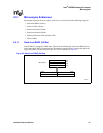
180 Hardware Reference Manual
Intel
®
IXP2800 Network Processor
Microengines
4.5 Event Signals
Event Signals are used to coordinate a program with completion of external events. For example,
when a Microengine issues a command to an external unit to read data (which will be written into a
Transfer_In register), the program must insure that it does not try to use the data until the external
unit has written it. There is no hardware mechanism to flag that a register write is pending, and then
prevent the program from using it. Instead the coordination is under software control, with
hardware support.
When the program issues the command to the external event, it can request that the external unit
supply an indication (called an Event Signal) that the command has been completed. There are 15
Event Signals per Context that can be used, and Local CSRs per Context to track which Event
Signals are pending and which have been returned. The Event Signals can be used to move a
Context from Sleep state to Ready state, or alternatively, the program can test and branch on the
status of Event Signals.
Event Signals can be set in nine different ways.
1. When data is written into S_TRANSFER_IN registers (part of S_Push_ID input)
2. When data is written into D_TRANSFER_IN registers (part of D_Push_ID input)
3. When data is taken from S_TRANSFER_OUT registers (part of S_Pull_ID input)
4. When data is taken from D_TRANSFER_OUT registers (part of D_Pull_ID input)
5. On InterThread_Sig_In input
6. On NN_Sig_In input
7. On Prev_Sig_In input
8. On write to Same_ME_Signal Local CSR
9. By Internal Timer
Any or all Event Signals can be set by any of the above sources.
When a Context goes to the Sleep state (executes a ctx_arb instruction, or a Command instruction
with ctx_swap token), it specifies which Event Signal(s) it requires to be put in the Ready state.
The ctx_arb instruction also specifies whether the logical AND or logical OR of the Event
Signal(s) is needed to put the Context into the Ready state.
When a Context Event Signals arrive, it goes to the Ready state, and then to the Executing state.
In the case where the Event Signal is linked to moving data into or out of Transfer registers
(numbers 1 through 4 in the list above), the code can safely use the Transfer register as the first
instruction (for example, using a Transfer_In register as a source operand will get the new read
data). The same is true when the Event Signal is tested for branches (br_=signal or br_!signal
instructions).
The ctx_arb instruction, CTX_Sig_Events, and CTX_Wakeup_#_Events Local CSR descriptions
provide details.


















